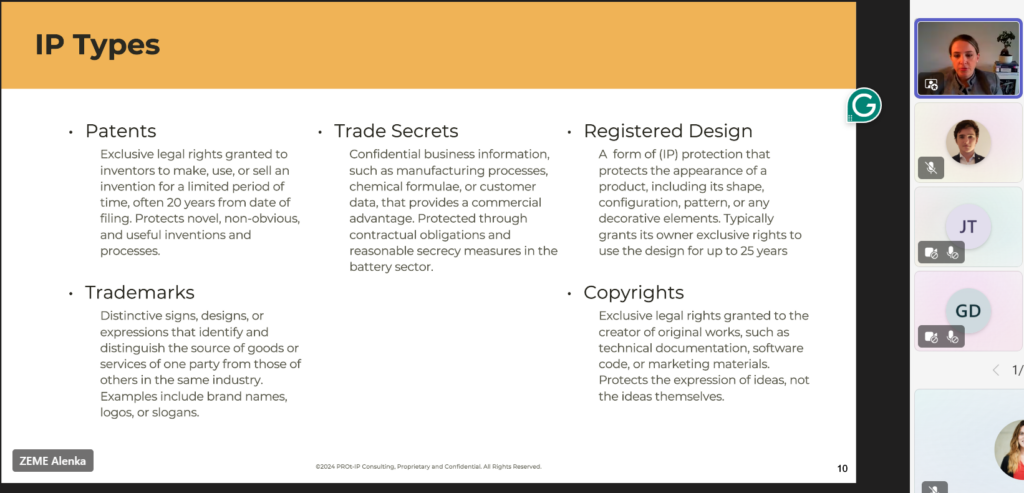Intellectual property management for battery innovations
17 September 2024

On 17 September 2024, BEPA organised a webinar on intellectual property in new battery technologies, crucial for navigating EU-funded projects in the battery field.
BEPA has organised a workshop on intellectual property management as part of the Innovation Uptake event series focusing on managing intellectual property in new battery technologies. Our speakers Alenka Zeme and Gene Lewis covered the following topics:
- Understanding IP in the battery industry
- Managing IP within a funded project consortium
- Understanding Investor Perspective on IP
- Identifying and valuing IP assets
Understanding intellectual property in the battery industry
Alenka Zeme is a postgraduate in intellectual property law, trained to address both the technical and legal aspects of intellectual property management. We can divide types of IP management in patents, trademarks, registered designs, and unregistered IP types that do not require registration.

” It is essential to understand the distinctions between the types of intellectual property because that enables you to choose the most appropriate form of protection.” Alenka Zeme
- Patents protect novel and non-obvious inventions, including processes, machines, and compositions. A patent grant owns the exclusive right to prevent others from making the same thing, using it, selling it, or importing it. Typically, it goes for 20 years. In the battery industry, patents can protect innovation in material designs and manufacturing processes.
- Trademarks protect distinctive brand elements: names, logos, or slogans. Trademark registration allows you to maintain your brand identity and also prevents confusion.
- Registered Designs are also a form of IP protection that protect the appearance, like the holistic appearance of the product. These designs can cover both two-dimensional and three-dimensional objects. Unlike patents, which protect the functional aspects of the technical solutions of a product, registered designs specifically focus on the visual elements that give this specific product a unique appearance. It typically grants its owner the exclusive right to use the design for a specific period, usually up to 25 years.
- Copyright protects creative works such as software, technical drawings, marketing materials, websites, or presentations. The copyright owners have the exclusive right to reproduce, distribute, or perform any changes to their original work.
- Unregistered IP types are not protected for a limited period and do not require registration. Instead, you must take reasonable measures to keep the information secret, using confidentiality agreements or implementing data security protocols. In the battery industry, trade secrets can protect proprietary information on battery formulation or any specific manufacturing techniques that we don’t want to disclose to anyone. An example of a famous trade secret is the recipe or formulation of Coca-Cola.
Filing for intellectual property protection can help you secure a competitive advantage in the market and will also make you more attractive to investments. IP protection ensures your company maintains control over its valuable innovation and protects your investments in research and development.
Prove to potential investors and all government funding agencies that you mitigated the risks associated with intellectual property disputes, by having a strong IP strategy.
IP protection for companies: a case study
 “The case study of LiNa Energy, a UK-based battery start-up, exemplifies the importance of IP protections for companies’ overall growth and success.” Alenka Zeme
“The case study of LiNa Energy, a UK-based battery start-up, exemplifies the importance of IP protections for companies’ overall growth and success.” Alenka Zeme
The company has developed an innovative solid-state sodium battery technology that promises higher energy density, faster charging, and improved safety compared to traditional lithium-ion batteries.
LiNa Energy’s successful IP strategy: They’ve created a patent portfolio to protect its unique solid-state battery technology. These patents cover various aspects of the innovation including material designs and manufacturing processes.
Then, the company registered trademarks in multiple jurisdictions to protect its brand identity and ensure that future customers can easily recognise and trust their product when launched. LiNa also implements strict confidentiality measures to protect its proprietary information. This includes non-disclosure agreements.
Managing IP within the consortium of a grant-funded project
Alenka clarified that IP rights facilitate collaboration and partnerships with other industrial players. For this purpose, it is important to have clear agreements on IP ownership and licensing in place because this can leverage complementary strengths.
A STEP BY STEP INSTRUCTION:
- Identify which party owns the IP generator during the project and how it will be allocated among the consortium members.
- Determine each party’s rights in terms of the use, development, or commercialisation of this IP and amend it if needed.
- Familiarise yourself with decision-making procedures and public guidelines (confidentiality and publication).
- Familiarise yourself with the consortium agreement which explains the IP-related workflows and responsibilities.
- Be careful with restrictions on sharing project information or publishing results.
- When drafting the IP provisions, the primary goal should be to create a flexible and efficient mechanism that will serve as a tool for cooperation between partners, typically for Horizon 2020 or Horizon Europe projects.
”The results of collaborative projects are often based on the combined knowledge of many partners, so they’re jointly created and jointly owned. That’s why partners need to agree on appropriate and shared strategies for its management, protection, and exploitation.” Alenka Zeme
In multi-partner funded projects, intellectual property (IP) is often jointly created and owned. Partners must have clear strategies for managing, protecting, and exploiting this IP. Before the start of the project, review the terms and conditions of the grant, in particular the Consortium Agreement (CA), which provides a legal framework for the management of IP. The CA should address:
- Ownership: Specify who owns the IP generated during the project and how it will be shared among the partners.
- Access rights: Define the rights each party has to use, develop, or commercialise the IP.
- Decision-making procedures: Establish rules for confidentiality, publication, and management of IP-related workflows.
The CA also includes details of each partner’s background IP. It is important to keep this agreement up to date throughout the project.
- When drafting IP provisions, aim to create a flexible and efficient system for partners to work together. For Horizon 2020 or Horizon Europe projects, the use of standardised model agreements such as DESKA 4 can help to simplify the process.
- Although not mandatory, partners should agree on background IP before signing the grant to ensure the necessary access rights for project implementation and exploitation of results. This agreement can be a separate document or part of the CA.
- Managing the different interests of research institutions focused on publication and SMEs interested in protecting their IP can be challenging. Establish a clear framework for organising and managing innovation activities to effectively manage dissemination and commercialisation.
- Understand and openly discuss the contributions and benefits of each partner to ensure successful collaboration. Remember that the initial agreement is just a starting point – negotiations and adjustments can be made throughout the project.
“In the case of Horizon projects, although not obligatory, it is recommended to have a written agreement on the IP background of the project before the grant is signed. This can be in the consortium agreement or a separate agreement.”
Understanding Investor Perspective on IP
 Gene Lewis has a background in material science, specifically in fuel cells. He then founded LiNa Energy where he led the core research and development team. Later, he worked for AFC Energy, the highlight there was that using what was then FP7 money they designed, built, installed and operated the world’s largest alkaline fuel cell system at a products facility. Gene is now a consultant working with universities on some interesting battery tech.
Gene Lewis has a background in material science, specifically in fuel cells. He then founded LiNa Energy where he led the core research and development team. Later, he worked for AFC Energy, the highlight there was that using what was then FP7 money they designed, built, installed and operated the world’s largest alkaline fuel cell system at a products facility. Gene is now a consultant working with universities on some interesting battery tech.
“I think it’s fair to say that patents get the lion’s share of interest. Put simply: investors, industry players, and potential partners love patents. ” Gene Lewis
What’s important is that with IP you can build tremendous credibility, as it is a strong foundation for a a business that is in a very tight competitive space.
What are some of the challenges with patents? When applying for a patent, you need to think about whether it will still have any value by the time it’s granted, as things can change along the journey.
A STEP BY STEP GUIDE:
- Defending a patent can drain an early-stage company’s resources and time.
- Having a patent doesn’t guarantee protection from others copying your idea.
- Startups should get a patent examiner review before seeking outside investment.
- The 18-month window allows time to pursue or amend patent claims.
- A well-drafted patent is critical; professional help is necessary to avoid mistakes.
- List only the true inventors on the patent.
- After 12 months, decide whether to continue and extend the patent to other regions.
- Evaluate if the invention still holds commercial value and amend claims if necessary.
- Consult a patent attorney for search and filing guidance.
- Involve the executive team for strategic decisions on costs and patenting.
- Regularly review the patent portfolio and manage trade secrets carefully.
Identifying and assessing IP assets
By identifying and assessing IP assets, companies can prevent competitors from replicating the production methods without the need for patenting, which would eventually make it public knowledge. The benefit of this is that it protects the company’s competitive position, so trademarks protect the brand identity of the company and its products.
Battery product line as a trademark, helps protect the brand’s identity and prevents confusion amongst consumers in the marketplace, so they know exactly that they’re using that product.
The benefit of copyrighting is that it prevents unauthorised copying or distribution of this software. It helps distinguish the product better in this competitive work market.
”Differentiate yourself from the competition and you can secure that very unique position in the marketplace; and secondly, if you need to attract investment, then you can demonstrate ownership of key IP assets.” Alenka Zeme
Legal and Practical Considerations in IP Management
To protect your trade secrets you should estimate the revenue potential or licencing opportunity and also market share. This will help forecast the future value and strength of your IP in the marketplace because the financial value of your IP assets is a key factor in determining the value of your IP. The key metrics here would be how much revenue the IP generates. This is either through direct sales, licensing, or royalty agreements.
“Your IP strategy and trade secret management should align with the overall business objectives of your organisation. You need robust internal IP policies, employee training, access controls, and NDAs to prevent any unauthorised disclosures.” Alenka Zeme
Non-Disclosure Agreements (NDA) provide a legal framework for maintaining the secure the secrecy of your valuable information. NDAs also create a safe space for open communication and collaboration between parties by setting clear boundaries and expectations for handling sensitive information. This encourages trust and transparency, which is essential for successful business relationships, especially when we talk about investments. If due diligence is to be performed on your innovations, it is also for maintaining the competitive edge by keeping your sensitive information confidential.


